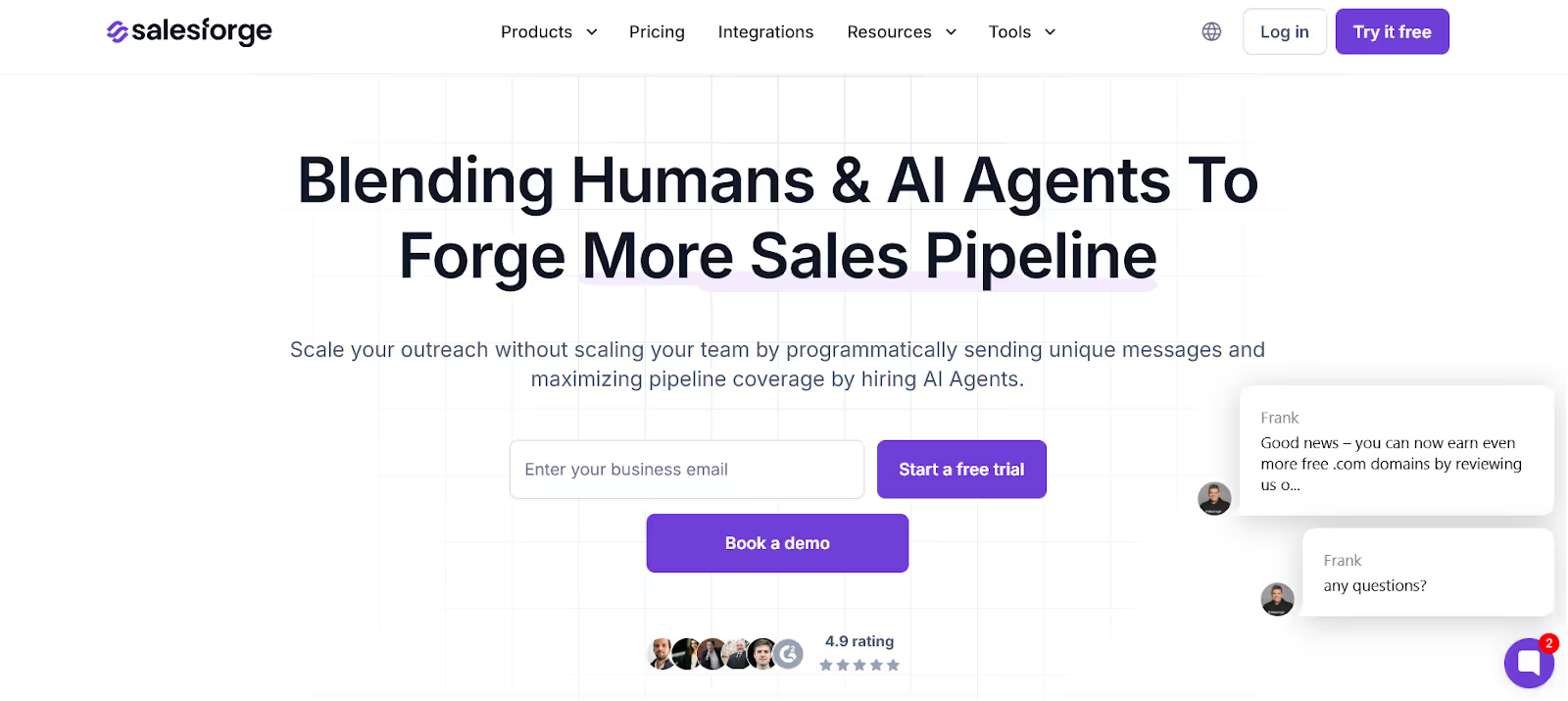GTM Engineer: Why do you need it
Let me be blunt.
Most founders don’t have a sales problem.
They have a go-to-market (GTM) execution problem.

Leads are leaking.
Reps are guessing.
Tools aren’t talking to each other.
You’re spending 10 hours/week duct-taping workflows, when that should be a system.
This is exactly where a GTM Engineer comes in.
Not another “RevOps hire.”
Not just a CRM admin.
A builder. A system thinker. A full-stack revenue operator.
In this blog, I’ll break down:
- ✅ What is a GTM Engineer, really (not just another buzzword)
- ✅ Why hiring one will 10x your sales efficiency before your sales headcount
- ✅ When you should hire (vs. automating with tools like Salesforge)
- ✅ What tech stack powers modern GTM execution
Whether you're a startup founder, agency owner, or sales leader tired of broken outbound…
This is the guide you’ve been looking for.
If you’ve been searching:
- What is a GTM Engineer
- GTM Engineer vs RevOps
- How to scale outbound without hiring 5 tools and 10 reps
...then read every word.
It’ll save you 6 months of painful trial and error, and thousands in wasted spend.
What Is a GTM Engineer? (And Why They’re Not Just ‘RevOps’ in Disguise)
A GTM Engineer is not just a fancy title for RevOps.
This is a completely different beast.
A GTM (Go-To-Market) Engineer is the person who builds the systems, automations, and integrations that connect your marketing, sales, and customer success into one seamless revenue engine.
They don’t just track pipeline, they architect it.
In simple terms, A GTM Engineer is the technical operator behind your revenue growth. Think of them as a hybrid of product-minded ops, API-savvy builder, and revenue strategist, all in one.
GTM Engineer vs RevOps vs Sales Ops: What’s the Difference?
- RevOps maintains the process.
- Sales Ops supports reps.
- GTM Engineers build infrastructure to automate growth at scale.
Why Every Scalable GTM System Needs an Engineer?
If you’re trying to build a repeatable go-to-market motion, you can’t rely on VLOOKUPs and Slack threads.
You need someone who can:
- Create API workflows between tools
- Set up outbound infrastructure (domains, DNS, warm-up)
- Automate lead routing, enrichment, and validation
- Deploy multi-touch sequences without manual input
- Monitor real-time revenue metrics beyond just attribution
In short, they don’t just maintain CRMs, they create pipelines.
Key Responsibilities of a GTM Engineer
Here’s exactly what GTM Enginners do (and how most teams get it wrong):
1. They Build a Clean Lead Flow — From Start to Send
If you’re pulling leads from LinkedIn or tools like Leadsforge, someone needs to clean that data, enrich it, check if the emails are valid, and send it to the right rep or sequence.
That’s what a GTM Engineer handles.
What usually goes wrong?
Teams dump a messy CSV into a tool, skip validation, and hit send.
Result? Bounces, spam complaints, and bad replies.
With a GTM Engineer, that whole flow is automated and safe.
2. They Fix Your CRM Logic and Lead Scoring
Most CRMs are a mess. You don’t know who’s a good lead, who needs follow-up, or where the deal came from.
A GTM Engineer sets clear rules:
- How to score a lead
- When to move them through the pipeline
- And where they actually came from (for real attribution)
Without them? Reps waste time on bad leads, and marketing gets blamed for “low quality.”
3. They Set Up the Right Email Infrastructure
Sending cold emails? Then you need working domains, warmed-up mailboxes, and technical stuff like SPF, DKIM, and DMARC done right.
A GTM Engineer sets up:
- Tools like Mailforge or Infraforge
- Domain rotation
- Warm-up processes
- All the things that protect your sender's reputation
What happens if you don’t?
You burn your domain on Day 1. No one sees your emails. And your campaigns flop before they start.
4. They Connect All Your Tools So Nothing Breaks
Your leads live in one tool. Emails are sent from another. CRM is separate. Reporting? In a spreadsheet.
A GTM Engineer ties it all together:
- Uses Zapier, APIs, and webhooks
- Makes sure data flows cleanly from tool to tool
- Sets it up once, so your team doesn’t do things manually
Without them? Your reps end up copy-pasting stuff every day and making mistakes that cost you deals.
5. They Track the Full Funnel — Not Just “Booked Meetings”
Most teams only look at top-of-funnel metrics:
- How many emails were sent
- How many meetings were booked
But a GTM Engineer goes deeper:
- Are emails landing in inboxes?
- Are replies turning into deals?
- Where are leads dropping off?
They give you the full picture so you can fix what’s not working.
Signs You Need a GTM Engineer ASAP
You might not think you need a GTM Engineer.
But if any of this sounds familiar, you probably needed one yesterday.
1. Your Reps Are Still Copy-Pasting Leads Manually
If your sales reps are spending time uploading spreadsheets, checking emails by hand, or fixing formatting issues…
That’s not sales. That’s admin work.
A GTM Engineer automates this, so reps can focus on closing, not cleaning data.
2. You’re Juggling 7 Different Tools to Send 1 Email
CRM in one tab. Email tool in another. Data enrichment? Somewhere else.
You’re duct-taping your go-to-market motion.
The more tools you stack without a proper system, the more fragile everything becomes.
A GTM Engineer connects your tools and removes the busywork between steps.
3. You Can’t Track Where Deals Are Coming From
You close a deal. Great.
But when someone asks, “How did we get this lead?”... there’s silence.
If you can’t answer that confidently, you’ve got an attribution gap.
A GTM Engineer helps fix your pipeline visibility, so you know exactly what’s working.
4. Your Emails Aren’t Hitting Inboxes
If cold emails are landing in spam, open rates are dropping, or domains keep getting flagged, it’s not just a messaging problem.
It’s an infrastructure problem.
A GTM Engineer makes sure your sending setup is clean, warm, and scalable, so your emails get seen, not blocked.
5. You’re Hiring More Reps, But Results Aren’t Scaling
If you keep increasing headcount but pipeline and revenue stay flat, your problem isn’t people, it’s process.
Scaling without systems creates more chaos.
A GTM Engineer lays the foundation for growth that doesn’t collapse under pressure.
In short, you don’t need to hire a GTM Engineer when things break.
You need one, so they never do.
And if hiring isn’t an option yet, tools like Salesforge give you the structure of a GTM system, already built in.
From automated lead flows to reliable email infrastructure, it’s the shortcut most founders wish they had earlier.
How Salesforge Replaces (or Powers) Your First GTM Engineer
Hiring a full-time GTM Engineer isn’t always possible, especially if you’re a small team or early-stage founder trying to keep costs down.
But the need for structure, automation, and clean outbound workflows doesn’t go away.
That’s where tools like Salesforge become practical. It’s not about replacing people; it’s about having the right foundation until you can build the team.

Here’s what Salesforge handles that would normally fall on a GTM Engineer:
- Setting up domains and mailboxes using Mailforge or Infraforge
- Automating warm-up and inbox rotation to keep deliverability high
- Sourcing and enriching leads with Leadsforge, based on your ICP
- Writing personalized messages using AI, without templates
- Running entire outreach flows across multiple mailboxes + multiple channels (email + LinkedIn)
- Tracking performance across inboxes, sequences, and reply rates
And suppose you’re already thinking about AI SDRs or outbound automation.
In that case, the platform includes tools like Agent Frank to manage prospecting, messaging, and even booking calls, like a hands-off version of an SDR backed by GTM infrastructure.
None of this replaces the strategic work a GTM Engineer can do.
But if you’re not ready to hire yet, or just want your outreach stack to actually work, platforms like Salesforge can give you the structure GTM Engineers usually build, without the custom setups or complex integrations.
GTM Engineering Stack: Tools You Need to Get Started
Here’s a breakdown of the core layers and what each tool is meant to handle:
Who Should You Hire First: GTM Engineer or SDR?
This question comes up a lot, especially for early-stage teams.
Do you hire an SDR to start outbound? Or bring in a GTM Engineer to build the foundation?
Let’s check:
How to Evaluate a GTM Engineer (If You’re Hiring)
Hiring your first GTM Engineer?
Trust me, it’s not like hiring any sales rep or a marketer.
Here you’re looking for someone who can think like a builder, work across teams, and connect the entire go-to-market system, without needing to be told what to do every step of the way.
Here’s how to know if someone’s actually ready for the role.
Must-Have Skills
The Right Traits
Red Flags to Watch For
Conclusion
Let’s wrap this up.
If you’ve made it this far, you now understand why most sales teams aren’t underperforming because of their reps…
They’re underperforming because their go-to-market engine is broken.
Here’s a quick recap of what we covered:
✅ What is a GTM Engineer, really, and how are they different from RevOps or Sales Ops
✅ Why every modern GTM system needs one, especially if you’re running outbound at scale
✅ The exact responsibilities they own, from lead flow to email infrastructure to performance tracking
✅ How to know when you’re ready to hire one, or what to use if you’re not
✅ The GTM tech stack they built, so your tools actually talk to each other
✅ Why hiring a GTM Engineer before an SDR makes financial sense, especially when output matters
✅ What to look for in your first GTM hire, and what red flags to avoid
✅ And finally, how one founder replaced 2 SDRs, saved $6K/month, and booked 3x more demos using a smart system powered by tools like Salesforge
Here’s the takeaway:
GTM Engineers don’t just improve your sales process. They unlock scale.
And if you’re not ready to hire one yet?
Platforms like Salesforge help you build the exact infrastructure a GTM Engineer would, so you can operate like a revenue machine, even as a lean team.
The best teams aren’t just doing more, they’re doing it better.
→ Start building your GTM engine with Salesforge.



.png)

.png)
